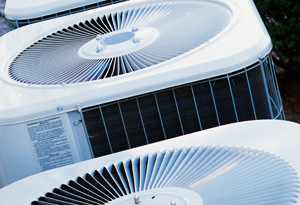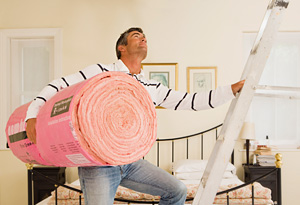Home Cooling Tips for Summer

Photo: Comstock/Thinkstock
Beat the heat this summer! Home improvement expert Tom Kraeutler shares low-cost (and no-cost!) tips to keep your home cool all season.
With summer upon us, keeping your home cool creates a welcome escape. But you don't have to get hot-headed in your attempts to beat the heat. There are lots easy ways to cool down—and cool off—without spending a fortune. Central Air Conditioning
If you are lucky enough to have a central air conditioning system, now is the time to have it serviced. Central air conditioners work by using a chemical refrigerant, like Freon, to soak up heat inside your house and then transfer that heat to the exterior.
Central air conditioning systems must be in tip-top shape for cooling a house efficiently. When properly working, the system should produce a temperature "differential" of 1 to 20 degrees, between return and supply air. This means that if the air being drawn into the system is 75 degrees, the air coming out should be at least 60 degrees. If it's not, your air conditioner is probably low on refrigerant and you are wasting electricity.
Even after servicing, make sure your central air conditioning system stays in shape by changing the filter at least once per month. At less than a dollar apiece, a clean filter can save you thousands on repairs by keeping the central air conditioning system free of clogs that can cause the compressor to break down.
Window Air Conditioning
Unlike central systems, window air conditioners don't need to be serviced each year. The installation, however, can make a big difference in how well the window air conditioner unit runs and how long it lasts. When setting a unit in the window, make sure it pitches slightly downward, toward the exterior, so that condensation trapped inside the window air conditioner unit will run out before it causes rust.
Next, make sure the gap between the half-open window and the window frame is filled with foam insulation. This keeps both warm air and insects from making their way into your house.
If the window unit has a three-prong plug, make sure to connect it to a grounded receptacle. If you must use a two-prong adapter, make sure you properly connect the adapter's grounding tap to the outlet. If you're unsure about electricity, don't take a chance—call in a professional electrician. Window air conditioners consume a lot of power, so it's important that they're wired properly.
Finally, once you have your window air conditioner unit installed, the window locks will no longer work. For security, cut a stick to fit between the top of the sash and the upper window frame. This may prevent a burglar from prying open your window.
Storm Windows
Keeping storm windows down when air conditioning is on actually helps keep your home cooler! Storm glass improves the thermal efficiency of your exterior windows and keeps cool air inside. One hint: Make sure the bottom of the storm window has "weep" holes. These small holes let water out of the inside of the storm window so trapped moisture won't rot your wooden window.
Discover 3 different fans to help keep you cool

Photo: Hamera Technologies/Thinkstock
Room Fans
Ever wonder just why you feel cooler when you stand in front of a fan, even though the air doesn't actually get cooler? The reason is something called "evaporate cooling." Basically, the moving air causes moisture on your skin to evaporate. As it does, the evaporation process cools your skin so you feel more comfortable. To take advantage of this effect, position room fans for maximum air circulation. If you're using a window fan, open another window across the room to provide good cross ventilation.
Ceiling Fans
Paddle fans are another popular version of the room fan and can help keep your home cool. While attractive, these ceiling fans are costly to run and an inefficient way to cool your home. One advantage paddle fans do have over other types is a reversible motor. By controlling the direction of the blades, you can use the fan to "pull" colder air up in the summer and "push" warm air down in the winter. Fans installed at the peak of cathedral ceilings can be very effective in winter by helping to recirculate warm air that would otherwise be wasted.
Whole House Fans
Probably one of the most effective and efficient low-cost systems for cooling your house is the "whole house fan." Not to be confused with smaller attic fans, these large fans are mounted in the ceiling of the uppermost floor of your home. They work by drawing air from open windows in the house into the attic, where it is released through enlarged vents to the exterior. The airflow in the house can be controlled by the number and location of open windows, as well as the speed of the fan, which usually has several settings. Also, by using a time switch, you can set the whole house fan to run for an hour or so while you're falling asleep, then automatically switch off at night. The whole house fan then automatically switches off and won't run all night when the temperature drops.
Get tips for using your attic to keep the whole house cool
Ever wonder just why you feel cooler when you stand in front of a fan, even though the air doesn't actually get cooler? The reason is something called "evaporate cooling." Basically, the moving air causes moisture on your skin to evaporate. As it does, the evaporation process cools your skin so you feel more comfortable. To take advantage of this effect, position room fans for maximum air circulation. If you're using a window fan, open another window across the room to provide good cross ventilation.
Ceiling Fans
Paddle fans are another popular version of the room fan and can help keep your home cool. While attractive, these ceiling fans are costly to run and an inefficient way to cool your home. One advantage paddle fans do have over other types is a reversible motor. By controlling the direction of the blades, you can use the fan to "pull" colder air up in the summer and "push" warm air down in the winter. Fans installed at the peak of cathedral ceilings can be very effective in winter by helping to recirculate warm air that would otherwise be wasted.
Whole House Fans
Probably one of the most effective and efficient low-cost systems for cooling your house is the "whole house fan." Not to be confused with smaller attic fans, these large fans are mounted in the ceiling of the uppermost floor of your home. They work by drawing air from open windows in the house into the attic, where it is released through enlarged vents to the exterior. The airflow in the house can be controlled by the number and location of open windows, as well as the speed of the fan, which usually has several settings. Also, by using a time switch, you can set the whole house fan to run for an hour or so while you're falling asleep, then automatically switch off at night. The whole house fan then automatically switches off and won't run all night when the temperature drops.
Get tips for using your attic to keep the whole house cool

Photo: Jupiterimages/Thinkstock
Attic Insulation
While most people think about installing attic insulation in the fall, insulation works equally well in the summer to keep hot attic air temperatures from penetrating the attic ceiling. Well-insulated homes should have a minimum of eight inches of ceiling insulation. Insulation is easy to install with just a few precautions. Make sure to cover exposed skin, especially when using fiberglass insulation. Also, be sure to wear a dust mask to prevent breathing in fiberglass particles and wear safety glasses to protect your eyes. If doing the attic insulation job in the summer, start early in the morning and quit well before the sun heats the attic to uncomfortable temperatures.
Attic Fans
Attic fans, mounted on the roof, are important when cooling your home by reducing the temperature of trapped warm air in the attic. If the attic is cooler, the house temperature will be lower and air conditioners will not have to work nearly as hard to keep the home at a comfortable temperature. Attic fans are inexpensive and run by a thermostat, which turns the attic fan on automatically whenever the attic temperature gets hot.
Attic Ventilation
Drafty attics, not drafty houses, make for very efficient heating and cooling. In fact, a well-ventilated attic should be as close to the ambient outside air temperature as possible. To achieve this, most homes should have a combination of ridge and soffit vents. The ridge vent, mounted along the entire peak of the roof, will allow trapped warm air and moisture in the attic to escape to the outside.
To make this happen however, lower vents must be added at the "soffit," which is at the underside of the roof overhang. With these vents installed, air is pushed into the soffits, rides up the underside of the roof sheathing, and exits the home at the ridge.
The nice thing about an attic ventilation system is that it works year round. Unlike attic fans, which run only in the summer and cost money to operate, ridge and soffit vents work together to take out hot air in the summer, cooling your home, while taking out trapped moisture in the winter, which can cause insulation to become damp and inefficient.
While most people think about installing attic insulation in the fall, insulation works equally well in the summer to keep hot attic air temperatures from penetrating the attic ceiling. Well-insulated homes should have a minimum of eight inches of ceiling insulation. Insulation is easy to install with just a few precautions. Make sure to cover exposed skin, especially when using fiberglass insulation. Also, be sure to wear a dust mask to prevent breathing in fiberglass particles and wear safety glasses to protect your eyes. If doing the attic insulation job in the summer, start early in the morning and quit well before the sun heats the attic to uncomfortable temperatures.
Attic Fans
Attic fans, mounted on the roof, are important when cooling your home by reducing the temperature of trapped warm air in the attic. If the attic is cooler, the house temperature will be lower and air conditioners will not have to work nearly as hard to keep the home at a comfortable temperature. Attic fans are inexpensive and run by a thermostat, which turns the attic fan on automatically whenever the attic temperature gets hot.
Attic Ventilation
Drafty attics, not drafty houses, make for very efficient heating and cooling. In fact, a well-ventilated attic should be as close to the ambient outside air temperature as possible. To achieve this, most homes should have a combination of ridge and soffit vents. The ridge vent, mounted along the entire peak of the roof, will allow trapped warm air and moisture in the attic to escape to the outside.
To make this happen however, lower vents must be added at the "soffit," which is at the underside of the roof overhang. With these vents installed, air is pushed into the soffits, rides up the underside of the roof sheathing, and exits the home at the ridge.
The nice thing about an attic ventilation system is that it works year round. Unlike attic fans, which run only in the summer and cost money to operate, ridge and soffit vents work together to take out hot air in the summer, cooling your home, while taking out trapped moisture in the winter, which can cause insulation to become damp and inefficient.
More from Tom Kraeutler






